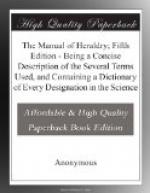Judges and Barons of the degree of the Coif, according to seniority
Viscounts’ younger Sons.
Barons’ younger Sons.
Baronets.
Knights of the Bath.
Knights Commanders of the Bath.
Field and Flag Officers.
Knights Bachelors.
Masters in Chancery.
Doctors graduate.
Serjeants at Law.
Esquires of the King’s Body.
Esquires of the Knights of the Bath.
Esquires by creation.
Esquires by office.
Clergymen, Barristers at Law, Officers in the Royal Navy and Army who
are Gentlemen by Profession, and Gentlemen entitled to bear arms.
Citizens.
Burgesses.
The Lords Spiritual of Ireland rank next after the Lords Spiritual of Great Britain; the priority of signing any treaty or public instrument by the members of the government is always taken by rank of place, not by title.
The style prefixed to the titles of the peerage of Great Britain and Ireland are as follows :—
Princes of the Blood, His Royal Highness.
Archbishops, His Grace.
Dukes, The Most Noble His Grace.
Marquesses, the Most Honorable.
Earls, Viscounts, and Barons, The Right
Honorable.
Bishops, The Right Reverend.
* * * * *
DICTIONARY OF HERALDIC TERMS.
ABAISSE. A French word, generally used in heraldry instead of the English word abased. When the fess, or any other ordinary properly placed above the fess point of the shield, is brought below it, that ordinary is said to be abaisse.
ABATEMENT. Any figure added to coats of arms tending to lower the dignity or station of the bearer. Thus, the baton, denoting illegitimacy, is an abatement: so, also, are the differences in coats of arms showing the degrees of consanguinity.
ADDORSED. Any animals set back to back. See LION.
ALLERION. An eagle displayed, without beak or feet.
[Illustration: Allerion]
Ex. Argent, an allerion gules.
ALTERNATE. Figures or tinctures that succeed each other by turns.
AMETHYST. A precious stone of a violet colour, the name of which was formerly used instead of purpure, to denote the purple tincture when emblazoning the arms of the English nobility.
ANNULET. A small circle borne as a charge in coats of arms.
[Illustration: Annulet]
Ex. Azure, an annulet argent. Annulets are added to arms for a difference. See DIFFERENCES, p. 13. [CHAP. III.]
ANCIENT. A small flag or ensign. The bearer of the flag was called by its name. Iago was ancient to the troops commanded by Othello.
“This is Othello’s ancient,
as I take it.
The same indeed, a very valiant fellow.”
SHAKSPEARE.
ARCHBISHOPS. Church dignitaries of the first class. There are but two in England—the Archbishop of Canterbury and the Archbishop of York. The former is the first peer of England next to the royal family, and has the title of Grace given to him; and likewise Most Reverend Father in God. He is styled Primate of all England, and Metropolitan.




